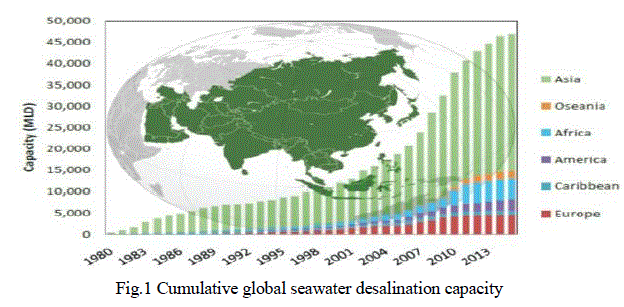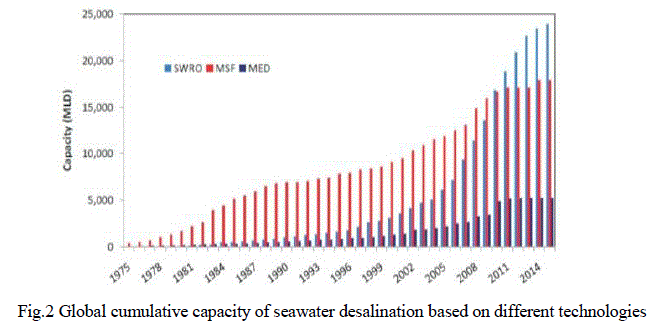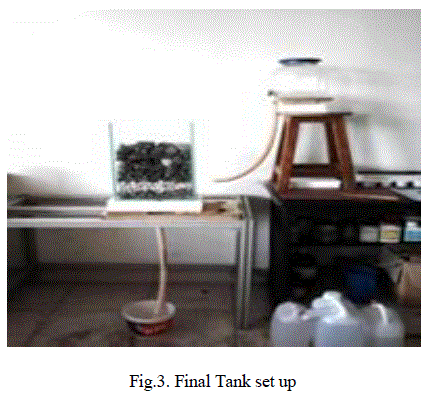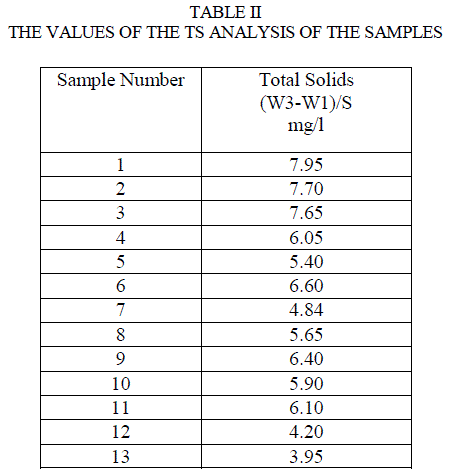ISSN ONLINE(2319-8753)PRINT(2347-6710)
ISSN ONLINE(2319-8753)PRINT(2347-6710)
Ashwin Shenoy1, Abhita Dhavamani2, Shifa S Fathima3, Jagadish H Patil4, Rajalakshmi M4
|
| Related article at Pubmed, Scholar Google |
Visit for more related articles at International Journal of Innovative Research in Science, Engineering and Technology
With increasing demand for potable water in regions lacking fresh water sources, various potential technologies have been explored for eliminating water shortage. Seawater emerged as a potential source for such water deprived areas. The development of seawater reverse osmosis technology proved to be a ground breaking innovation, making it easier to extract pure water from seawater. Seawater reverse osmosis technology has taken many leaps towards the development of energy efficient and high yielding systems. The reduction in energy consumption, improvement in membrane life and increase in energy recovery emerged as the primary criteria for research in this field. The key objective of the work involves the optimization of the variables involved in the pre-treatment process of a seawater reverse osmosis plant which would lead to an increase in the membrane life by reducing solids content of the raw water. Experiments were carried out to ensure maximum total solids reduction. A combination of sedimentation, disk and ultra-filtration processes was tested in order. The type (gravel and pebbles), size (4-65 mm) and depth (1 inch to 14 inch) of filtration media were varied. The results obtained were acceptable, leading to a 51.21% reduction in the total solids content of the raw water and a resultant silt density index of 2, much better than the present 10% TS reduction in plant. These parameters were found to be desirable for the discharge from the pre-treatment to be fed into the reverse osmosis part of the plant.
Keywords |
| Reverse osmosis, Total solids, Silt density index,Sedimentation |
I. INTRODUCTION |
| More than 60% of the world’s population resides in Asia, and the continent is fast becoming a powerful engine for global economic growth. Rapid economic growth can be buttressed only by the strong support of infrastructure like power and water facilities. Moreover, continuous population expansion calls for more and better quality fresh water, thereby underscoring the increasingly critical need for reliable sources of water. Given the fixed supply of fresh water globally from conventional sources like streams and underground aquifers, simple economic thinking dictates that to meet rising demand, supply from non-traditional sources must rise, such as sea water desalination. Figure 1 shows the global sea water desalination capacity has continuously increased over the past 30 years, especially in the past decade. This is a clear indicationthat drawing fresh water from the sea has gained traction in time in Asia, and today, sea water desalination in Asia accounts for almost 70 % of the global capacity [1]. |
| Multistage Flash Distillation (MSF), Multiple Effect Distillation (MED) and Sea Water Reverse Osmosis (SWRO) are three main technologies that have dominated the seawater desalination market. MSF commanded the greatest influence in the industry before 2000, but SWRO has quickly gained popularity, with the accumulative capacity of SWRO exceeding MSF’s capacity in 2009-2010 as shown in Figure2.The pre-treatment process in the desalination plant presently is a unique combination of three non-conventional pre-treatment technologies namely sedimentation, disk filtration and Ultra filtration. |
| The primary aim of pre-treatment is to reduce the Total Solids (TS) content of the raw water as much as possible to make it a suitable feed for the Reverse Osmosis (RO) plant. If the raw water has a high Suspended Solids (SS) in it, the life of the RO membrane is expected to reduce exponentially. So, the raw water is subjected to the combination of the three processes mentioned above. |
 |
| Presently, the amount of SS removal is less than 10 % in the first step of the pre-treatment process, the sedimentation tank. This solids separation rate was considered extremely low and it was proposed to increase this rate as much as possible by varying the parameters involved in the sedimentation part of the pre-treatment process. Hence, an experiment was devised to fabricate a pilot model of the sedimentation tank, vary the filtration media size, shape and depth and design the bed and test it so that it has the maximum SS separation efficiency possible. |
II. LITERATURE SURVEY |
| Desalination refers to any of several processes that remove some amount of salt and other minerals from saline water [2]. Salt water is desalinated to produce fresh water suitable for human consumption, industrial use and irrigation. Most of the modern interest in desalination is focused on developing cost-effective ways of providing fresh water for human use [3]. Along with recycled wastewater, this is one of the few rainfall-independent water sources. Large-scale desalination typically uses large amounts of energy and specialized, expensive infrastructure, making it more expensive than fresh water from conventional sources, like rivers or groundwater [4]. Desalination is an increasingly common solution to supply fresh water in many regions of the world where this resource is scarce [5]. Among all desalination technologies, SWRO is the most internationally widespread technology. It is fully mature and is present in all coastal areas in the world with limited natural hydrological resources [6]. Lot of research work has been done using Membrane Filtration (MF) pre – treatment that provides steady and predictable quality of feed water supply for RO system resulting in 40% increase in flux over conventional pre-treatment methods [7]. Cardona et. al. [8] used polypropylene membrane of 0.2 μm pore diameter in continuous mode under a pressure gradient of 100 Kpa, an energy saving of 13- 15% has been reported with insertion of MF membrane pre-treatment system. Teng et. al. [9] observed that the higher permeate flux of the MF membrane pilot system was achieved at the cost of increased transmembrane pressure with Silt Density Index (SDI) in the permissible limit of RO feed. Ceramic membranes have longer life span due to their chemical and mechanical stability, Ahmad and Mariadas [10] used tubular single channel ceramic membranes with nominal pore size of 0.2 μm and found that the insertion of helical baffle increased the permeate flux (520.8 LMH) up to 104.9% as compared to a system without baffle using feed of 1.0 g/l TiO2 at 20 psi TMP. |
III. MATERIALS AND METHODS |
| A. Reverse Osmosis |
| Diffusion is the movement of molecules from a region of higher concentration to a region of lower concentration. Osmosis is a special case of diffusion in which the molecules are water and the concentration gradient occurs across a semi permeable membrane [11]. A semi permeable membrane allows the passage of water, but not ions (e.g., Na+, Ca2+, Cl-) or larger molecules (e.g., glucose, urea, bacteria). Diffusion and osmosis are thermodynamically favourable and will continue until equilibrium is reached. Osmosis can be made slower, stopped, or even reversed if sufficient pressure is applied to the membrane from the 'concentrated' side of the membrane [12], [13]. Reverse osmosis occurs when the water is moved across the membrane against the concentration gradient, from lower concentration to higher concentration. In reverse osmosis, pressure is exerted on the side with the concentrated solution to force the water molecules across the membrane to the fresh water side [14]. |
| RO is a purification technology that uses a semi permeable membrane. This membrane-technology is not exactly a filtration method because in RO, an applied pressure is used to overcome osmotic pressure, the colligative property (explained in the previous section), that is driven by chemical potential, a thermodynamic parameter [15]. The result is that the solute is retained on the pressurized side of the membrane and the pure solvent is allowed to pass to the other side. To be "selective," this membrane should not allow large molecules or ions through the pores (holes), but should allow smaller components of the solution (such as the solvent) to pass freely [16], [17]. In the normal osmosis process, the solvent naturally moves from an area of low solute concentration (high water potential), through a membrane, to an area of high solute concentration (low water potential) [18]. |
| The movement of a pure solvent is driven to reduce the free energy of the system by equalizing solute concentrations on each side of a membrane, generating osmotic pressure. Applying an external pressure to reverse the natural flow of pure solvent, thus, is reverse osmosis. The process is similar to other membrane technology applications [19]. However, there are key differences between reverse osmosis and filtration. The predominant removal mechanism in membrane filtration is straining or size exclusion, so the process can theoretically achieve perfect exclusion of particles regardless of operational parameters such as influent pressure and concentration [20]. Moreover, RO involves a diffusive mechanism so that separation efficiency is dependent on solute concentration, pressure and water flux rate [21]. |
| B. Pre treatment |
| It is well established from the literature that Reverse Osmosis (RO) membranes are sensitive to pH, oxidisers, bacteria, algae, organics and particulates. Therefore, it is crucial to treat the raw water before sending it into the RO trains by making it a suitable feed for a long lasting membrane life. For this purpose, several pre-treatment technologies and their combinations are being used with successful results and desirable efficiency. In the present plant the pre-treatment section of plant consists of a combination of three popular pre-treatment technologies namely sedimentation, disk filtration and ultra-filtration. |
IV. EXPERIMENTAL WORK |
| The main aim of this experiment was to achieve as much reduction in the TS content of the raw water as possible so that the stress and energy involved in the next two sections namely, disk filters and UF can be reduced. The raw water TS content is less than 10 mg/l and the reduction of TS achieved from this sedimentation pit is less than 10% in plant. So the goal of this experiment was to increase this reduction rate of TS by using filtration media of different size, shape and texture. Later, the particular sample water that has the maximum separation was to be taken to the next sections (Disk filters and UF) and tested to see the final separation of solids obtained. It should be noted that in the pretreatment process only the SS in the raw water will be removed. The water devoid of most of the SS will then be sent into the RO chamber for removal of Dissolved Solids (DS). |
| A. Analysis of raw water |
| Laboratory analysis of the sample sea water was done to set the range of parameters which eventually have to be reduced after sedimentation. The parameters tested were TS content and the pH. The TS analysis was done by muffle oven test and the pH analysis was done using a pH-meter. |
| B. Construction of pilot model of the sedimentation tank |
| A down-flow sedimentation tank model was used since thepressure required to drive the intake liquid into the tank from bottom is difficult to achieve,. The difference between both these flow methods regarding filtration and separation rate is negligible. The tank was designed in such a way that it would have a raw water dispenser at the top and a discharge collector at the bottom. The tank model specifications are shown in Figure. Normal lab equipment’s which were least expensive were used. The tank was made of 8mm Borosilicate glass with an opening at the bottom fitted with a clamp along with piping for the inflow and outflow of raw water into and from the sedimentation tank. The tank dimension was 18x12x6 inches with cuboid shape. The final tank set up is shown in Figure 3. |
 |
| C. Filtration media |
| The two filtration media namely gravel and pebbles, ranging from 4mm to 65 mm, were obtained. Gravel was separated into three different sizes and four different sized pebbles were used as shown in Fig 4. They were then washed thoroughly and dried under lab conditions. |
 |
| Thirteen different combinations with respect to the order of seven layers of filtration media to be used in the tank were made. Every single combination was put into the tank for testing. The combination with the lowest TS result for the discharge of sample water was to be decided as the final design of the bed. |
| The sea water was dispensed through thirteen combinations of the seven filtration media layers. After the raw water flowed through the media, it was collected in a receiver tank. It should be noted that in every trial, larger sized media was placed on top and the size reduced with the depth. The raw water that passed though the thirteen combinations were collected and tested for their TS content. 20 ml of sample was collected from each trial and placed in a muffle oven for 4 hours under a temperature ranging from 1030 to 1260 centigrade. Thirteen trial with all the Seven layers arranged in decreasing order of size from the top has the highest TS reduction efficiency. The sample water that was flown through this particular trial was further sent into individual skids of Disk filters and UF modules and the final TS and SDI were found. Then the sample water is sent into the RO chamber. |
V. RESULTS AND DISCUSSIONS |
| A. Result |
| The TS content of the raw waterwas found by the muffle oven test. Sample water volume (S) – 20ml. The pH analysis was done with a pH meter. The TS and pH meter values obtained are tabulated in table I. |
 |
| The set of values were obtained after the analysis of the sample discharge water of the thirteen trials from the sedimentation tank. The values of the TS analysis of the samples are shown in table II (Here S = 20ml of sample). |
 |
| Sample number 13 which is the outflow from the sedimentation tank had the least TS content among all the trials. This sample was the chosen for further analysis. The sample water was sent into a single skid of disk filters and analysed for the TS content which showed the removal of particles upto 100 microns. The final stage of pre-treatment, flowing through the UF trains the discharge was found to have a silt density index of 2. |
| B. Inference |
| The following can be inferred from the results of the experimental part: |
| The present sedimentation unit in the SWRO plant has a TS reduction of only 10%. |
| i. As inferred from the results of thirteen different trials with various filtration media bed configurations, it can be concluded that trial number 13 with all the Seven layers arranged in decreasing order of size from the top has the highestTS reduction efficiency. |
| ii. The size range used in this trial was 4mm to 65mm with a bed depth of 14 inches for an 18 inch tank. |
| iii. The original TS found to be in the range of 8 to 9 mg/L has been reduced to 3.95 mg/l |
| iv. Percentage TS reduction of Trial 13: | (3.95-8.10) / (8.10) | * 100% = 51.2346 % |
| v. This is a much higher value compared to the plain gravel bed sedimentation tank used presently in the SWRO plant. Hence, the achieved result is extremely desirable. |
| vi. As far as the sedimentation tank in the pre-treatment process is concerned, it can be concluded that a filtration bed with a combination of gravels and pebbles of size ranging from 4 mm to 65 mm gives a 50% reduction in the TS content of the raw water which reduces a lot of work load on and increases the life of the pre-treatment steps that follow. |
| vii. The second and the third pre-treatment processes finally yielded an SDI of 2 which is found to be perfectly desirable parameter for the feed to the Reverse Osmosis section of the SWRO plant. |
| viii. Any feed that enters the RO train with an SDI of more than 3 would reduce the life of the RO membrane to 7 to 10 month’s minimum and 1.5 years maximum. Whereas, an SDI of 2 gives a life of 5 years with replacement to an RO membrane |
VI. CONCLUSION |
| It is well established that there is an evolving lack of fresh water availability due to several reasons like population blast, ground water depletion, climatic change, global warming, etc. To meet this rising demand of potable water, there is an ever-growing requirement of novel, energy efficient, economically viable technologies that would yield fresh water for domestic and industrial consumption. Seawater is presently the most popular sources of water for these kinds of technologies due to its abundant and free availability. Hence, seawater desalination technologies are being worked upon all around the world to device an efficient method to purify seawater for human consumption.Pre-treatment of raw water is an absolute necessity before sending in the feed for desalination into a RO plant. Failing to do so exponentially reduces the membrane, and hence, the plant life.The primary aim of this entire process is to reduce the TS content of the raw water as much as possible to make it a workable feed for the RO trains. Presently, the sedimentation tank is an up-flow pit with a TS reduction of only 10%. Hence, an experiment was designed to increase the TS reduction rate by varying the sedimentation pit parameters. |
| For a filtration bed depth of thirteen inches in an eighteen inches tank and filtration media size ranging between 4 to 65 mm made of a combination of gravel and pebbles, a TS reduction rate of 51.23% was obtained. This reduction rate is much desirable and the sample discharge water from the pilot sedimentation tank was taken directly for further analysis. It was sent into a single skid of disk filters which resulted in solids separation upto 11 microns. This was followed by sending the disk filter discharge sample into UF modules resulting in a discharge with a Salt Density Index (SDI) of 2 which is highly desirable to be a viable feed to the RO part of the plant. Hence, it can be concluded that with an increased size range of 4 mm to 65 mm and a combination of gravel and pebbles-textured filtration media, an increased rate of TS reduction can be achieved. |
ACKNOWLEDGMENT |
| We wish to thank Dr.S Veezhinathan, Mecon Ltd for his support, suggestions and pertinent remarks in carrying out this work. |
References |
|